Wheat Yield and Protein Estimation with Handheld and Unmanned Aerial Vehicle-Mounted Sensors
Abstract
:1. Introduction
2. Materials and Methods
2.1. Experimental Locations
2.2. Unmanned Aerial System
2.3. Multispectral Image Acquisition and Processing
2.4. Handheld Sensor Data Collection
2.5. Post-Harvest Data Analysis
2.6. Statistical Analysis
3. Results and Discussion
3.1. Relationship between GS NDVI and UAV NDVI
3.2. Relationship between GS NDVI and UAV NDVI and Grain Yield
3.3. Relationship between GS NDVI and UAV NDVI and Grain N Uptake
3.4. Relationship between GS NDVI and UAV NDVI and Grain Protein Content
4. Conclusions
Author Contributions
Funding
Data Availability Statement
Conflicts of Interest
References
- Walsh, O.S.; Belmont, K.M. Improving Nitrogen-Use Efficiency in Idaho Crop Production; University of Idaho Extension: Moscow, ID, USA, 2015. [Google Scholar]
- Walsh, O.S.; Girma, K. Environmentally smart nitrogen performance in Northern Great Plains’ spring wheat production systems. Int. J. Agron. 2016, 2016, 8969513. [Google Scholar] [CrossRef] [Green Version]
- Aula, L.; Omara, P.; Nambi, E.; Oyebiyi, F.B.; Raun, W.R. Review of active optical sensors for improving winter wheat nitrogen use efficiency. Agronomy 2020, 10, 1157. [Google Scholar] [CrossRef]
- Ondoua, R.N.; Walsh, O. Precision agriculture advances and limitations: Lessons to the stakeholders. Crops Soils. 2017, 50, 40–47. [Google Scholar] [CrossRef]
- Radoglou-Grammatikis, P.; Sarigiannidis, P.; Lagkas, T.; Moscholios, I. A compilation of UAV applications for precision agriculture. Comp. Net. 2020, 172, 107–148. [Google Scholar] [CrossRef]
- Walsh, O.S.; Shafian, S.; Marshall, J.M.; Jackson, C.; McClintick-Chess, J.R.; Blanscet, S.M.; Swoboda, K.; Thompson, C.; Belmont, K.M.; Walsh, W.L. Assessment of UAV based vegetation indices for nitrogen concentration estimation in spring wheat. Adv. Rem. Sens. 2018, 7, 71–90. [Google Scholar] [CrossRef] [Green Version]
- Reza, M.N.; Na, I.S.; Baek, S.W.; Lee, K.-H. Rice yield estimation based on K-means clustering with graph-cut segmentation using low-altitude UAV images. Biosyst. Eng. 2019, 177, 109–121. [Google Scholar] [CrossRef]
- Hassan, M.A.; Yang, M.; Rasheed, A.; Yang, G.; Reynolds, M.; Xia, X.; Xiao, Y.; He, Z. A rapid monitoring of NDVI across the wheat growth cycle for grain yield prediction using a multi-spectral UAV platform. Plant Sci. 2019, 282, 95–103. [Google Scholar] [CrossRef] [PubMed]
- Duan, T.; Chapman, S.; Guo, Y.; Zheng, B. Dynamic monitoring of NDVI in wheat agronomy and breeding trials using an Unmanned Aerial Vehicle. Field Crop. Res. 2017, 210, 71–80. [Google Scholar] [CrossRef]
- Zeng, L.; Peng, G.; Meng, R.; Man, J.; Li, W.; Xu, B.; Lv, Z.; Sun, R. Wheat yield prediction based on unmanned aerial vehicles-collected red–green–blue imagery. Rem. Sens. 2021, 13, 2937. [Google Scholar] [CrossRef]
- Veverka, D.; Chatterjee, A.; Carlson, M. Comparisons of sensors to predict spring wheat grain yield and protein content. Agron. J. 2021, 113, 2091–2101. [Google Scholar] [CrossRef]
- Zhou, X.; Kono, Y.; Win, A.; Matsui, T.; Tanaka, T.S. Predicting within-field variability in grain yield and protein content of winter wheat using UAV-based multispectral imagery and machine learning approaches. Plant Prod. Sci. 2021, 24, 137–151. [Google Scholar] [CrossRef]
- Wang, L.; Tian, Y.; Yao, X.; Zhu, Y.; Cao, W. Predicting grain yield and protein content in wheat by fusing multi-sensor and multi-temporal remote-sensing images. Field Crop. Res. 2014, 164, 178–188. [Google Scholar] [CrossRef]
- Ogaya, R.; Peñuelas, J. Experimental drought in a holm oak forest: Different photosynthetic response of the two dominant species, Quercus ilex and Phillyrea latifolia. Env. Exp. Bot. 2003, 50, 137–148. [Google Scholar] [CrossRef]
- Teixeira, A.A.; Mendes Júnior, C.W.; Bredemeier, C.; Negreiros, M.; Aquino, R.d.S. Evaluation of the radiometric accuracy of images obtained by a Sequoia multispectral camera. Engen. Agríc. 2020, 40, 759–768. [Google Scholar] [CrossRef]
- Naser, M.A.; Khosla, R.; Longchamps, L.; Dahal, S. Using NDVI to differentiate wheat genotypes productivity under dryland and irrigated conditions. Rem. Sens. 2020, 12, 824. [Google Scholar] [CrossRef] [Green Version]
- Walsh, O.S.; Marshall, J.; Nambi, E.; Shafian, S.; Jayawardena, D.; Jackson, C.; Lamichhane, R.; Owusu Ansah, E.; McClintick-Chess, J. Spring wheat yield and grain quality response to nitrogen rate. Agron. J. 2022, 114, 2562–2572. [Google Scholar] [CrossRef]
- Raun, W.R.; Solie, J.B.; Johnson, G.V.; Stone, M.L.; Lukina, E.V.; Thomason, W.E.; Schepers, J.S. In-season prediction of potential grain yield in winter wheat using canopy reflectance. Agron. J. 2001, 93, 131–138. [Google Scholar] [CrossRef] [Green Version]
- Walsh, O.S.; Marshall, J.; Jackson, C.; Nambi, E.; Shafian, S.; Jayawardena, D.M.; Lamichhane, R.; Ansah, O.E.; McClintick-Chess, J.R. Wheat yield and protein estimation with handheld-and UAV-based reflectance measurements. Agrosyst. Geosci. Environ. 2022, 5, e20309. [Google Scholar] [CrossRef]
- Fowler, D.; Brydon, J.; Darroch, B.; Entz, M.; Johnston, A. Environment, and genotype influence on grain protein concentration of wheat and rye. Agron. J. 1990, 82, 655–664. [Google Scholar] [CrossRef]
- Littell, R.; Milliken, G.; Stroup, W.; Wolfinger, R. SAS System for Mixed Models; SAS Institute. Inc.: Cary, NC, USA, 1996. [Google Scholar]
- Ya, N.N.C.; Lee, L.S.; Ismail, M.R.; Razali, S.M.; Roslin, N.A.; Omar, M.H. Development of rice growth map using the advanced remote sensing techniques. In Proceedings of the International Conference on Computer and Drone Applications (IConDA), Kuching, Malaysia, 19–21 December 2019. [Google Scholar]
- Caturegli, L.; Gaetani, M.; Volterrani, M.; Magni, S.; Minelli, A.; Baldi, A.; Brandani, G.; Mancini, M.; Lenzi, A.; Orlandini, S. Normalized Difference Vegetation Index versus Dark Green Colour Index to estimate nitrogen status on bermudagrass hybrid and tall fescue. Int. J. Rem. Sens. 2020, 41, 455–470. [Google Scholar] [CrossRef]
- Brown, B.; Walsh, O.S. Planting Dates in Wheat Production; University of Idaho Extension: Moscow, ID, USA, 2016. [Google Scholar]
- Thiry, D.; Sears, R.G.; Shroyer, J.P.; Paulsen, G.M. Planting date effects on tiller development and productivity of wheat. Kans. Agric. Exp. St. Res. Rep. 2002, 12, 96. [Google Scholar]
- Kiersten Wise, B.J.; Mansfield, C.; Krupke, C. Managing Wheat by Growth Stage; ID 422. Purdue Extension; Purdue University: West Lafayette, IN, USA, 2011. [Google Scholar]
- Miller, T.D. Growth stages of wheat. Better crops with plant food. Potash Phosphate Inst. 1992, 76, 12. [Google Scholar]
- Walsh, O.S.; Klatt, A.; Solie, J.; Godsey, C.; Raun, W. Use of soil moisture data for refined GreenSeeker sensor-based nitrogen recommendations in winter wheat (Triticum aestivum L.). Precis. Agric. 2013, 14, 343–356. [Google Scholar] [CrossRef] [Green Version]
- Zhang, J.; Liu, X.; Liang, Y.; Cao, Q.; Tian, Y.; Zhu, Y.; Cao, W.; Liu, X. Using a portable active sensor to monitor growth parameters and predict grain yield of winter wheat. Sensors 2019, 19, 1108. [Google Scholar] [CrossRef] [Green Version]
- Osborne, S.L. Utilization of existing technology to evaluate spring wheat growth and nitrogen nutrition in South Dakota. Commun. Soil Sci. Plant. Anal. 2007, 38, 949–958. [Google Scholar] [CrossRef]
- Feng, M.; Yang, W. Changes in NDVI and yield of winter wheat cultivars with different plant types. Zhongguo Shengtai Nongye Xuebao/Chinese J. Eco-Agric. 2011, 19, 87–92. [Google Scholar] [CrossRef]
- Freeman, K.; Raun, W.; Johnson, G.; Mullen, R.; Stone, M.; Solie, J. Late-season prediction of wheat grain yield and grain protein. Commun. Soil Sci. Plant. Anal. 2003, 34, 1837–1852. [Google Scholar] [CrossRef]
- Girma, K.; Martin, K.; Anderson, R.; Arnall, D.; Brixey, K.; Casillas, M.; Chung, B.; Dobey, B.; Kamenidou, S.; Kariuki, S. Mid-season prediction of wheat-grain yield potential using plant, soil, and sensor measurements. J. Plant Nutr. 2006, 29, 873–897. [Google Scholar] [CrossRef] [Green Version]
- Moges, S.; Raun, W.; Mullen, R.; Freeman, K.; Johnson, G.; Solie, J. Evaluation of green, red, and near infrared bands for predicting winter wheat biomass, nitrogen uptake, and final grain yield. J. Plant Nutr. 2005, 27, 1431–1441. [Google Scholar] [CrossRef]
- Inman, D.; Khosla, R.; Reich, R.; Westfall, D. Normalized difference vegetation index and soil color-based management zones in irrigated maize. Agron. J. 2008, 100, 60–66. [Google Scholar] [CrossRef]
- Stone, M.; Solie, J.; Raun, W.; Whitney, R.; Taylor, S.; Ringer, J. Use of spectral radiance for correcting in-season fertilizer nitrogen deficiencies in winter wheat. Transact. Amer. Soc. Agric. Eng. 1996, 39, 1623–1631. [Google Scholar] [CrossRef]
- Reeves, D.; Mask, P.; Wood, C.; Delaney, D. Determination of wheat nitrogen status with a hand-held chlorophyll meter: Influence of management practices. J. Plant Nutr. 1993, 16, 781–796. [Google Scholar] [CrossRef]
- Sembiring, H.; Lees, H.; Raun, W.; Johnson, G.; Solie, J.; Stone, M.; DeLeon, M.; Lukina, E.; Cossey, D.; LaRuffa, J.; et al. Effect of growth stage and variety on spectral radiance in winter wheat. J. Plant Nutr. 2000, 23, 141–149. [Google Scholar] [CrossRef]
- Cao, Q.; Miao, Y.; Feng, G.; Gao, X.; Li, F.; Liu, B.; Yue, S.; Cheng, S.; Ustin, S.L.; Khosla, R.J. Active canopy sensing of winter wheat nitrogen status: An evaluation of two sensor systems. Comp. Electron. Agric. 2015, 112, 54–67. [Google Scholar] [CrossRef]
- Lukina, E.; Stone, M.; Raun, W. Estimating vegetation coverage in wheat using digital images. J. Plant Nutr. 1999, 22, 341–350. [Google Scholar] [CrossRef]
- Walsh, O.S.; Torrion, J.A.; Liang, X.; Shafian, S.; Yang, R.; Belmont, K.M.; McClintick-Chess, J.R. Grain yield, quality, and spectral characteristics of wheat grown under varied nitrogen and irrigation. Agrosyst. Geosci. Environ. 2020, 3, e20104. [Google Scholar] [CrossRef]
- Walsh, O.S.; Christiaens, R. Urea, ESN, and urea–ESN blends performed equally well as nitrogen sources for spring wheat. Crops Soils. 2014, 47, 36–41. [Google Scholar] [CrossRef]
- Wang, C.; Feng, M.-C.; Yang, W.-D.; Ding, G.-W.; Sun, H.; Liang, Z.-Y.; Xie, Y.-K.; Qiao, X.-X. Impact of spectral saturation on leaf area index and aboveground biomass estimation of winter wheat. Spectro. Let. 2016, 49, 241–248. [Google Scholar] [CrossRef]
- Jia, L.; Yu, Z.; Li, F.; Gnyp, M.; Koppe, W.; Bareth, G.; Miao, Y.; Chen, X.; Zhang, F. Nitrogen status estimation of winter wheat by using an Ikonos satellite image in the north China plain. In Computer and Computing Technologies in Agriculture; Li, D.V., Chen, Y., Eds.; Springer: Berlin/Heidelberg, Germany, 2012; Volume 369, pp. 174–184. [Google Scholar]
- Ren, J.; Chen, Z.; Zhou, Q.; Tang, H. Regional yield estimation for winter wheat with MODIS-NDVI data in Shandong, China. Int. J. Appl. Earth Observ. Geoinform. 2008, 10, 403–413. [Google Scholar] [CrossRef]
- Benincasa, P.; Antognelli, S.; Brunetti, L.; Fabbri, C.A.; Natale, A.; Sartoretti, V.; Modeo, G.; Guiducci, M.; Tei, F.; Vizzari, M. Reliability of NDVI derived by high resolution satellite and UAV compared to in-field methods for the evaluation of early crop N status and grain yield in wheat. Exper. Agric. 2018, 54, 604–622. [Google Scholar] [CrossRef]



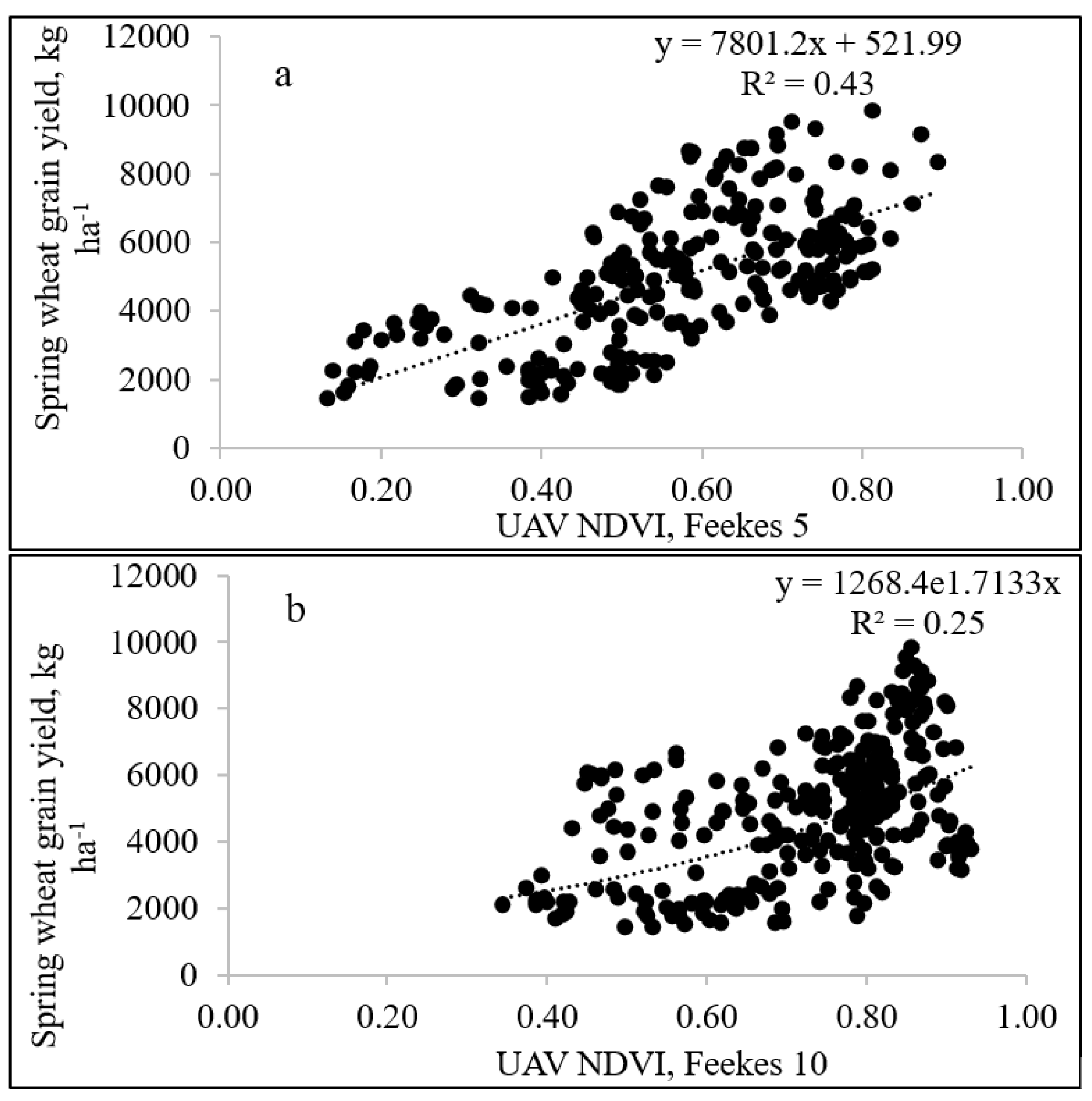
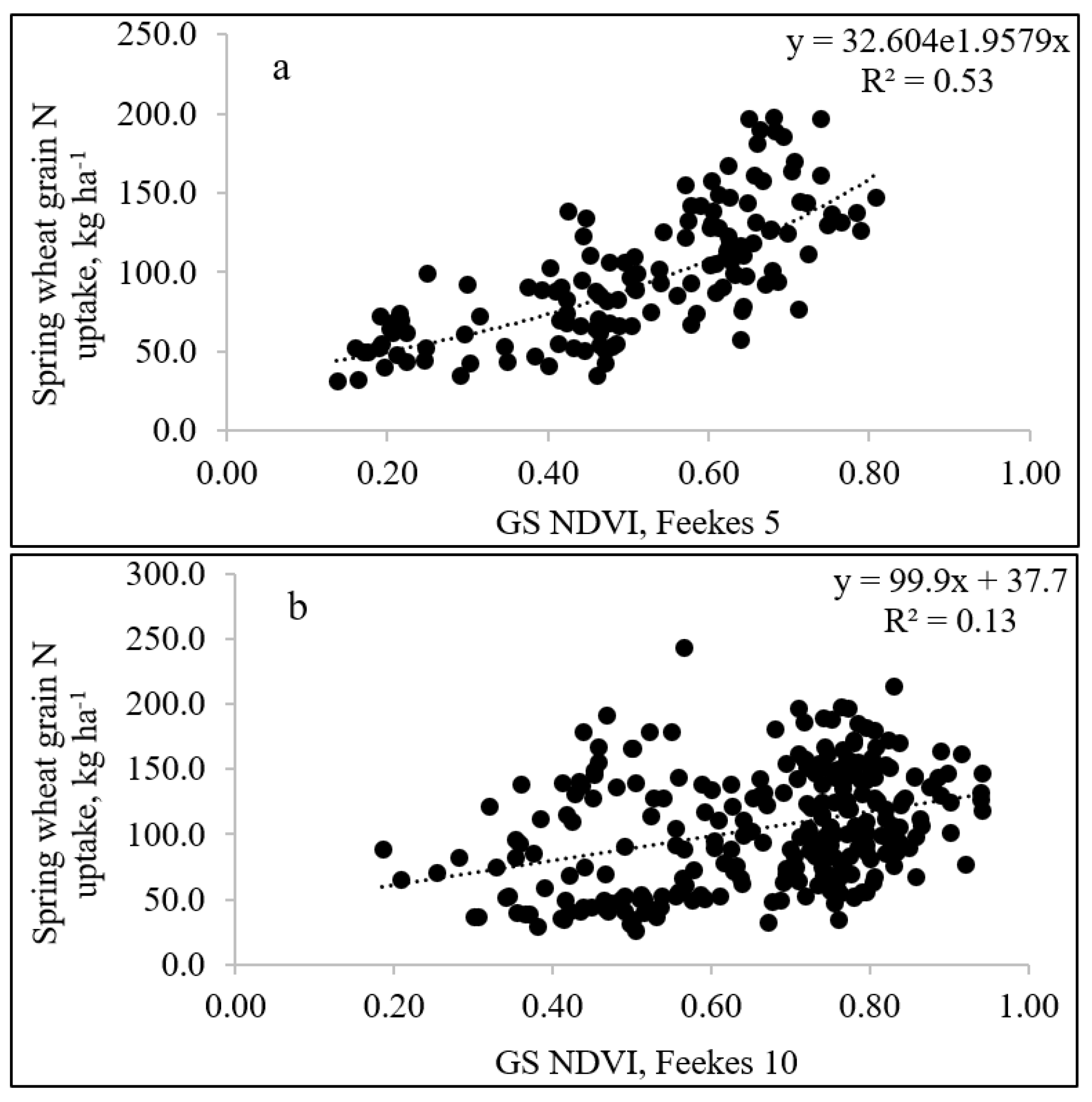
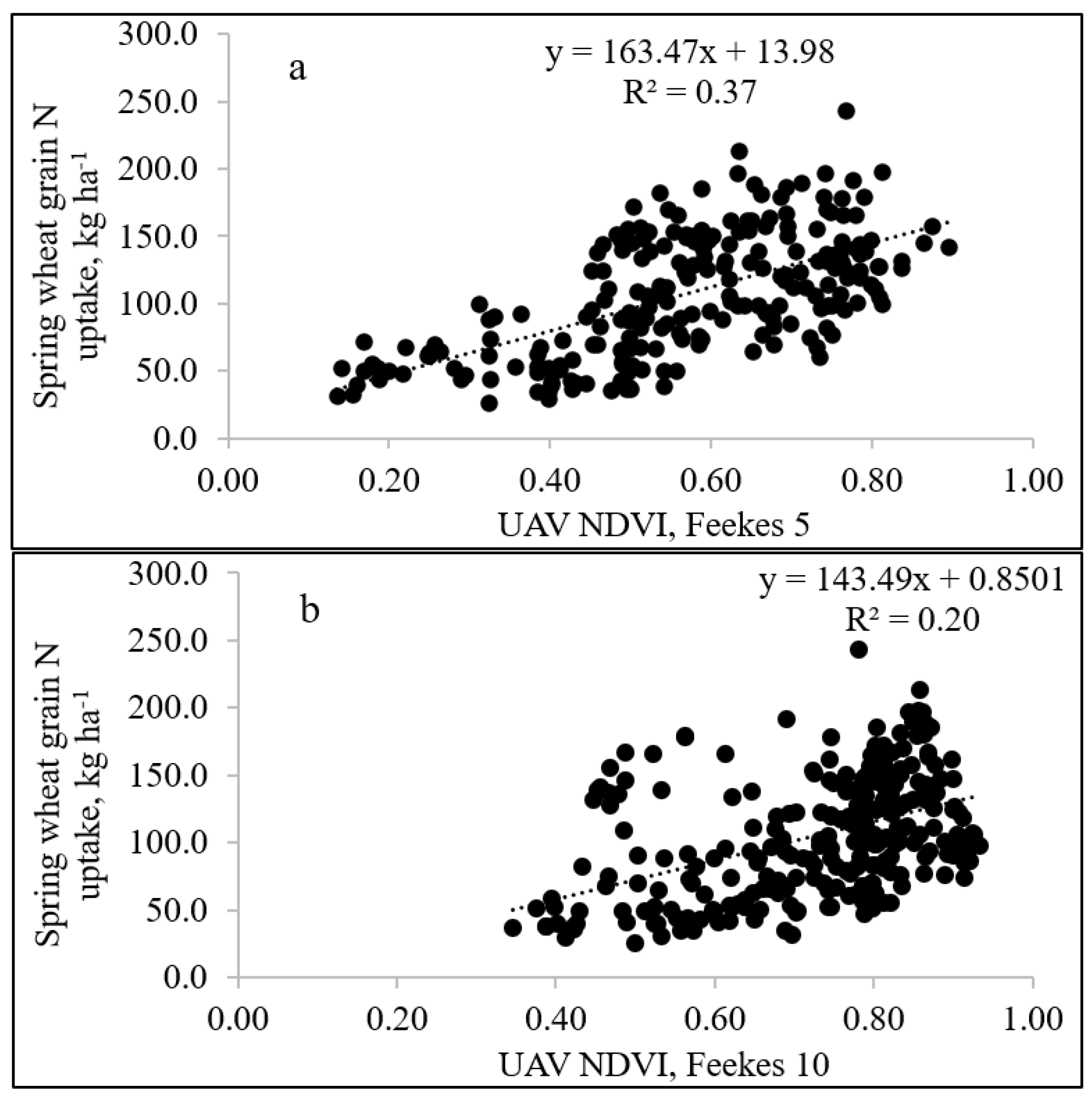
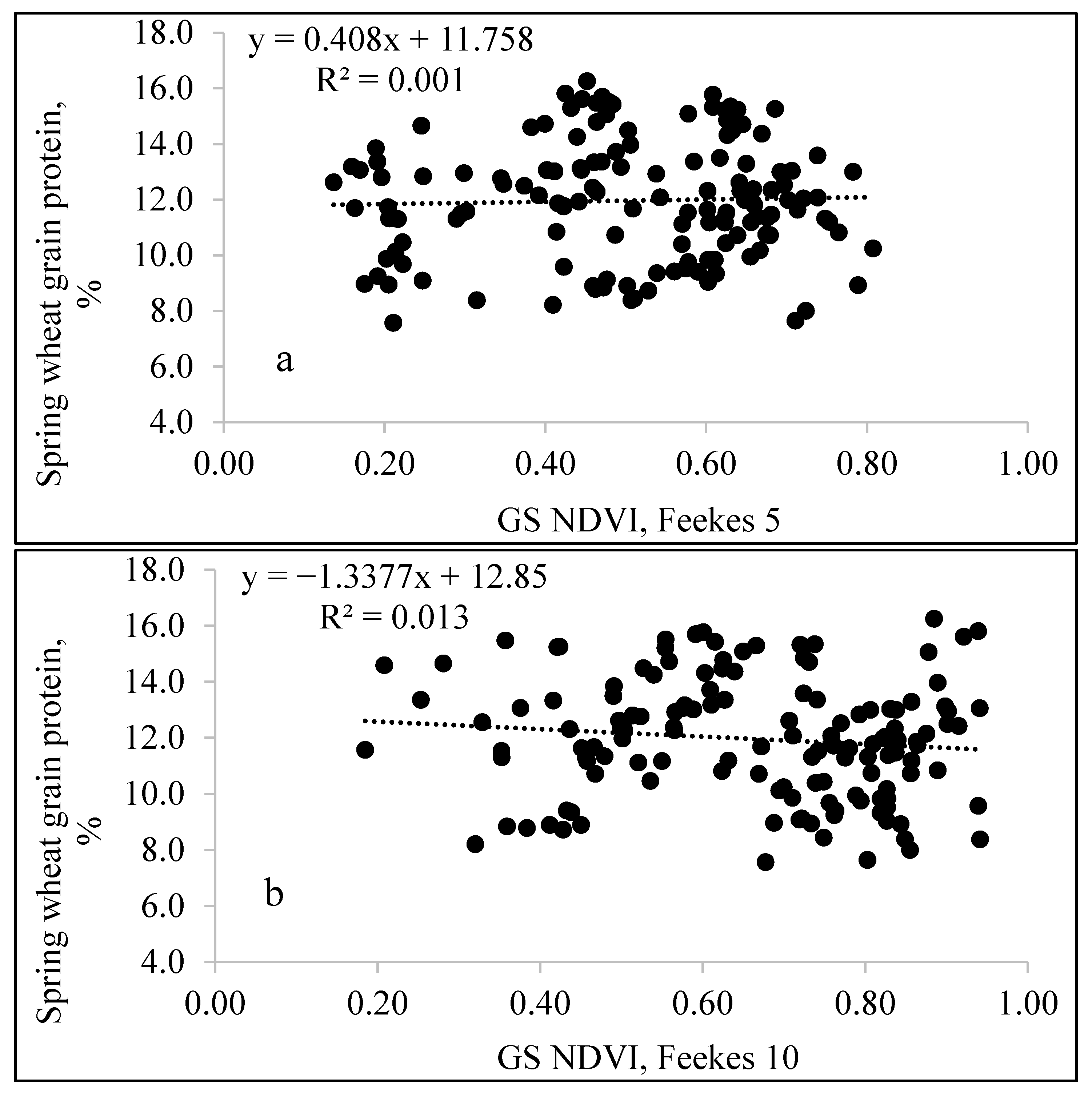
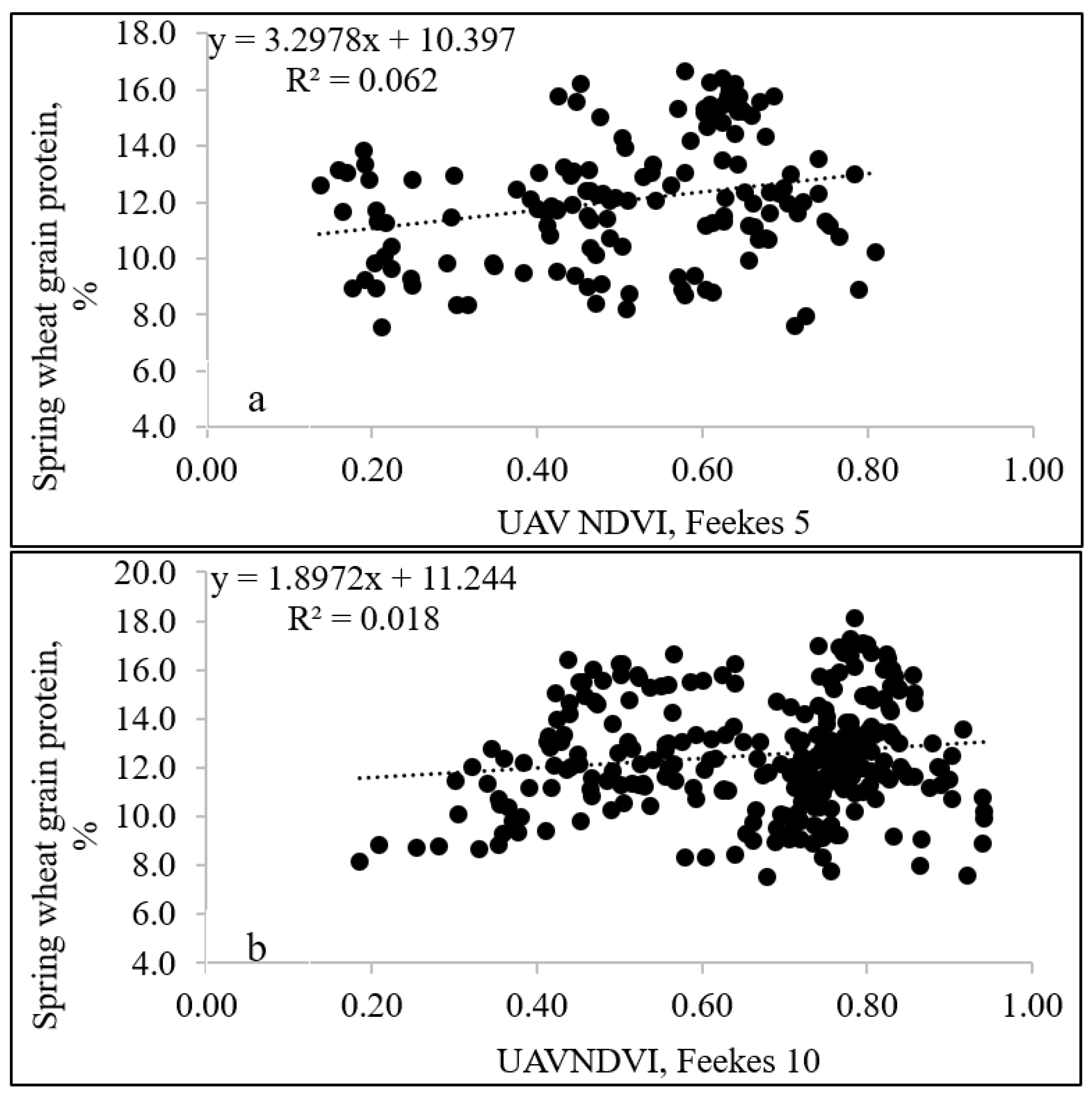
| Parameter | GS NDVI, Feekes 5 | GS NDVI, Feekes 10 | UAV NDVI, Feekes 5 | UAV NDVI, Feekes 10 |
|---|---|---|---|---|
| Grain yield | 0.56 * <0.0001 | 0.34 * <0.0001 | 0.66 * <0.0001 | 0.52 * <0.0001 |
| Grain N uptake | 0.51 * <0.0001 | 0.36 * <0.0001 | 0.61 * <0.0001 | 0.47 * <0.0001 |
| Grain protein | −0.03 0.68 | 0.14 0.02 | 0.001 0.99 | 0.04 0.47 |
Disclaimer/Publisher’s Note: The statements, opinions and data contained in all publications are solely those of the individual author(s) and contributor(s) and not of MDPI and/or the editor(s). MDPI and/or the editor(s) disclaim responsibility for any injury to people or property resulting from any ideas, methods, instructions or products referred to in the content. |
© 2023 by the authors. Licensee MDPI, Basel, Switzerland. This article is an open access article distributed under the terms and conditions of the Creative Commons Attribution (CC BY) license (https://creativecommons.org/licenses/by/4.0/).
Share and Cite
Walsh, O.S.; Marshall, J.M.; Nambi, E.; Jackson, C.A.; Ansah, E.O.; Lamichhane, R.; McClintick-Chess, J.; Bautista, F. Wheat Yield and Protein Estimation with Handheld and Unmanned Aerial Vehicle-Mounted Sensors. Agronomy 2023, 13, 207. https://doi.org/10.3390/agronomy13010207
Walsh OS, Marshall JM, Nambi E, Jackson CA, Ansah EO, Lamichhane R, McClintick-Chess J, Bautista F. Wheat Yield and Protein Estimation with Handheld and Unmanned Aerial Vehicle-Mounted Sensors. Agronomy. 2023; 13(1):207. https://doi.org/10.3390/agronomy13010207
Chicago/Turabian StyleWalsh, Olga S., Juliet M. Marshall, Eva Nambi, Chad A. Jackson, Emmanuella Owusu Ansah, Ritika Lamichhane, Jordan McClintick-Chess, and Francisco Bautista. 2023. "Wheat Yield and Protein Estimation with Handheld and Unmanned Aerial Vehicle-Mounted Sensors" Agronomy 13, no. 1: 207. https://doi.org/10.3390/agronomy13010207







